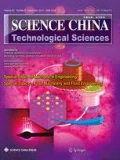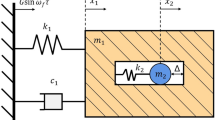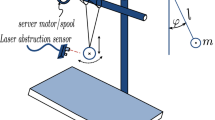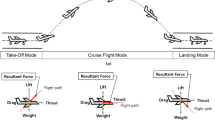Abstract
In this study, we used global analytical modeswfny (GAMs) to develop a rigid-flexible dynamic modeling approach for spacecraft with large flexible appendages (SwLFA). This approach enables the convenient and precise calculation of the natural characteristics for designing an attitude control law for the spacecraft while simultaneously suppressing the active vibration of its flexible appendages. We simplify the flexible spacecraft as a rigid-flexible coupling hub-beam system with tip mass and derive the system’s governing equations of motion based on Hamilton’s principle. By solving the linearized form of those equations with their associated boundary conditions, we obtain the frequencies as well as the corresponding GAMs of flexible spacecraft, which we use to discretize the equations of motion. Using this approach, we performed numerical simulations to investigate the system’s global modes and assess the performance of the controller based on the GAM model. The results reveal that the GAM model can be used to directly calculate the exact global modes of SwLFAs and that the controller based on the discrete GAM model can achieve a control-index for a SwLFA in a shorter time with less input energy than other methods.
Similar content being viewed by others
References
Karray F, Grewal A, Glaum M, et al. Stiffening control of a class of nonlinear affine systems. IEEE Trans Aerosp Electron Syst, 1997, 33: 473–484
Singh S N, Zhang R. Adaptive output feedback control of spacecraft with flexible appendages by modeling error compensation. Acta Astronaut, 2004, 54: 229–243
Bang H, Ha C K, Kim J H. Flexible spacecraft attitude maneuver by application of sliding mode control. Acta Astronaut, 2005, 57: 841–850
Hu Q, Ma G. Variable structure control and active vibration suppression of flexible spacecraft during attitude maneuver. Aerosp Sci Tech, 2005, 9: 307–317
Yang J B, Jiang L J, Chen D C. Dynamic modelling and control of a rotating Euler-Bernoulli beam. J Sound Vib, 2004, 274: 863–875
Lee K W, Singh S N. adaptive control of flexible spacecraft despite disturbances. Acta Astronaut, 2012, 80: 24–35
Sales T P, Rade D A, de Souza L C G. Passive vibration control of flexible spacecraft using shunted piezoelectric transducers. Aerosp Sci Tech, 2013, 29: 403–412
Dietz S, Wallrapp O, Wiedemann S. Nodal vs. modal representation in flexible multibody system dynamics. In: Ambrósio J A C, ed. Multibody Dynamics 2003. IDMEC/IST, Lisbon, Portugal, July 1–4, 2003. 1–20
Pan K Q, Liu J Y. Investigation on the choice of boundary conditions and shape functions for flexible multi-body system. Acta Mech Sin, 2012, 28: 180–189
Schwertassek R, Wallrapp O, Shabana A A. Flexible multibody simulation and choice of shape functions. Nonlinear Dyn, 1999, 20: 361–380
Schwertassek R, Dombrowski S V, Wallrapp O. Modal representation of stress in flexible multibody simulation. Nonlinear Dyn, 1999, 20: 381–399
Li Q, Wang T S, Ma X R. Reduced model of flexible sail-boom interaction for solar sail dynamics. In: 60th International Astronautical Congress. Daejeon: International Astronautical Federation, 2009. 5045–5055
Zhang J, Wang T S. Coupled attitude-orbit control of flexible solar sail for displaced solar orbit. J Spacecraft Rockets, 2013, 50: 675–685
Bampton M C C, Craig Jr. R R. Coupling of substructures for dynamic analyses. AIAA J, 1968, 6: 1313–1319
Kammer D C, Allen M S, Mayes R L. Formulation of an experimental substructure model using a Craig-Bampton based transmission simulator. J Sound Vib, 2015, 359: 179–194
Bellezza F, Lanari L, Ulivi G. Exact modeling of the flexible slewing link. In: Proceedings of the IEEE International Conference on Robotics and Automation. Cincinnati: IEEE, 1990. 734–739
Kuo C F J, Lin S C. Discretization and computer simulation of a rotating Euler-Bernoulli beam. Math Comput Simul, 2000, 52: 121–135
Vakil M, Fotouhi R, Nikiforuk P N, et al. A study of the free vibration of flexible-link flexible-joint manipulators. P I Mech Eng C-J Mech Eng Sci, 2011, 225: 1361–1371
Wei J, Cao D, Wang L, et al. Dynamic modeling and simulation for flexible spacecraft with flexible jointed solar panels. Int J Mech Sci, 2017, 130: 558–570
Gasbarri P, Sabatini M, Leonangeli N, et al. Flexibility issues in discrete on-off actuated spacecraft: Numerical and experimental tests. Acta Astronaut, 2014, 101: 81–97
Liu L, Cao D, Tan X. Studies on global analytical mode for a threeaxis attitude stabilized spacecraft by using the Rayleigh-Ritz method. Arch Appl Mech, 2016, 86: 1927–1946
Lachiver J M. Pléiades: Operational programming first results. In: Proceedings of the SpaceOps 2012 Conference. Stockholm, 2012
Hu Z D, Hong J Z. Modeling and analysis of a coupled rigid-flexible system. Appl Math Mech, 1999, 20: 1167–1174
Cai G P, Hong J Z, Yang S X. Dynamic analysis of a flexible hubbeam system with tip mass. Mech Res Commun, 2005, 32: 173–190
Cai G P, Lim C W. Active control of a flexible hub-beam system using optimal tracking control method. Int J Mech Sci, 2006, 48: 1150–1162
Author information
Authors and Affiliations
Corresponding author
Rights and permissions
About this article
Cite this article
Liu, L., Cao, D. & Wei, J. Rigid-flexible coupling dynamic modeling and vibration control for flexible spacecraft based on its global analytical modes. Sci. China Technol. Sci. 62, 608–618 (2019). https://doi.org/10.1007/s11431-017-9219-1
Received:
Accepted:
Published:
Issue Date:
DOI: https://doi.org/10.1007/s11431-017-9219-1




